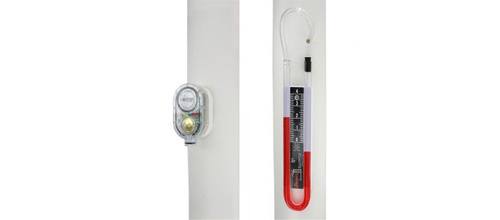
January is National Radon Action Month
At Tiger Group, we participate annually in the EPA’s National Campaign for Radon Action Month. For 2021 we are highlighting “Radon Fan Failure Alarms”.
Why Radon Fan Failure Alarms? Because they are virtually non-existent, that’s right, they are more difficult to find than baby pigeons (never seen one, have you?) When you think about awareness in this context, you might be surprised to know that a tiny percentage of vacuum systems (description below) have an alarm. This is not to say the systems lack a monitoring device, they do, it’s called a U-tube Manometer. The problem with the manometer is you must remember to go and find it and then read what it says. How are we supposed to remember to do that?
If you have a piped radon mitigation system in your house, (also known as a sub-slab mitigation or depressurization system) you will have something that looks similar to the illustration above. Which is a piped system that begins below the floor at the lowest level of your home, a manometer, a fan, and a vent terminal above the roofline.
There are a variety of different potential configurations, but the components will all be represented somewhere inside or outside of your home, this is a pretty basic installation. Notice there is no Audible Alarm.
While we don’t install these mitigation systems, we test a ton of homes that have radon mitigation installed, and on occasion, we find some that just don’t work. In fact, as Connecticut’s leading radon testing company, we are frequently the first to discover that systems are not working when we arrive onsite to perform testing. The problem, of course, is we have no idea how long the system has been off. If the system is not functioning, your family is not being protected and that is troubling.
The solution is to have an audible alarm installed; you can contact your radon mitigation contractor and they can install one for you, it’s that simple. If it is important enough to have a mitigation system in the home, and it is, then ensuring proper operation is critical.
The Active Audible Alarm alerts the owner to radon system failure, which could be a fan failure, ice or condensation buildup, or some other type of pipe blockage; basically, anything that interrupts the airflow will set the alarm off. An Active Audible Alarm is essential to keeping you aware of the system’s operational status and highly desirable when the U-tube manometer is installed in a hard to view location.
To be effective these Active Audible Alarms must meet several requirements. The device should be:
- Made of durable materials and labeled for occupant identification purposes.
- Be able to automatically reset after a power outage (for AC powered units) and include a low battery warning feature when the primary power is battery operated.
- Have separate power supplies from the fan unit, able to operate in low pressure and low airflow systems, and not susceptible to false alarms.
There are a variety of alarm systems on the market, retailing from $50 – $150 plus the cost of installation. And, many are simple to install, so if you’re handy it could be a do-it-yourself job.
Here’s a few to consider – click for videos:
RadonAway Air Flow Alarm Installation – YouTube
RSA1 Alarm Installation – YouTube
Off The Rack: Tjernlund RA1 Fan Failure Alarm – YouTube
It is important to remember, audible alarms alert you when the system is not functioning. However, alarms are not a substitute for testing. Every mitigation device manufacturer has a recommendation for re-testing every two years to ensure the mitigation system continues to perform well to protect your family from high levels of radon gas.
Even if you don’t have a radon mitigation system in your home, if you haven’t had a radon test in the past two years, now would be a very good time to have one completed. With many folks being home more now than in the past, it would be a safe way to start the year.
If you require reliable testing from an independent third party, certified to conduct radon testing in your home, we would be happy to assist. Contact our Environmental Services Team, and we will make the arrangements to conduct the testing for your peace of mind, and a healthy start to 2021!